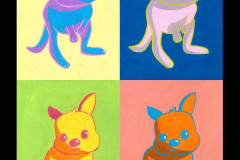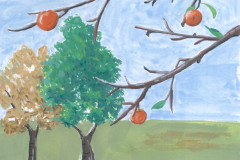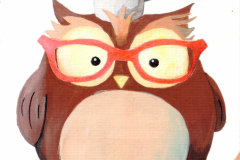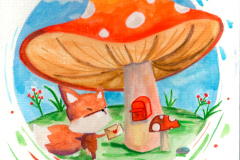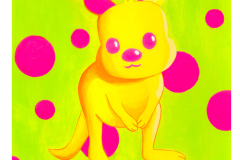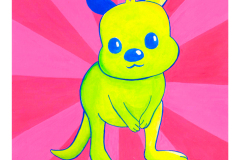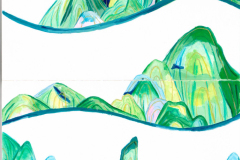Introduction
Gouache painting offers a way to express creativity with bold, opaque colors that can revive your artistic spirit. This medium blends the qualities of watercolor and acrylic, allowing you to create vibrant, matte finishes. If you face challenges breaking through creative blocks, engaging with daily gouache painting exercises will shift your mindset and refresh your skills. These exercises are designed to ignite your inspiration and help you develop new techniques.
In this article, you will find practical approaches to use gouache in your daily practice. You will explore how simple routines can help overcome creative hurdles by building confidence and inviting experimentation. The insights shared here aim to motivate you to pick up your brush, break the cycle of hesitation, and embrace the unique properties of gouache to unlock your artistic potential.
Understanding Gouache and Its Unique Qualities
Gouache is a type of paint that blends water, pigment, and a binding agent like gum arabic. Its pigment concentration is higher than watercolor, making it thick and dense. This thickness gives gouache a unique opacity, allowing you to paint solid layers that cover what’s beneath completely.
When wet, gouache behaves like watercolor, flowing smoothly and mixing easily. After drying, it becomes matte and flat but can be reactivated with water, unlike acrylics that dry hard and permanent. This quality lets you adjust or repaint without waiting too long.
You can use gouache on various surfaces such as paper, board, or canvas. Its quick drying time makes it practical for artists working on tight deadlines or those who enjoy layering colors fast. Knowing how gouache works helps you plan your painting process and experiment with different effects.
What Makes Gouache Different
Gouache stands out because of its opacity compared to watercolor’s transparency. It contains more pigment and less water, so colors appear vibrant and solid. This lets you paint light colors over dark ones, a technique harder to achieve with watercolor.
The texture of gouache feels creamy when wet and smooth matte when dry. This change affects how you layer and blend colors. Dry gouache can crack if applied too thickly but allows for sharp edges and flat color areas that watercolor can’t offer.
It reacts to water after drying but in a gentler way than watercolor. You can soften edges or reactivate colors selectively, giving you control over texture and detail. Do you find yourself needing paint that shifts between soft washes and solid blocks? Gouache could be the medium you’ve been searching for.
Common Uses of Gouache
Gouache is popular among artists and designers for posters, illustrations, comics, and animations. Its vibrant, flat colors suit graphic styles and printed work where clarity and boldness matter.
Many illustrators choose gouache because it dries quickly, allowing for fast revisions and layering without losing brightness. Comic artists value its ability to create clean lines and uniform color fills. Animators use it for background paintings due to its consistency and easy control.
Besides commercial uses, gouache is great for daily creative practice. It challenges you to think about layers and edges differently than watercolor or acrylic. Have you tried using a medium that supports quick changes and sharp contrasts? Gouache might inspire fresh ideas in your work.
Setting Up Your Space for Daily Gouache Painting
You need a workspace that invites creativity and supports daily gouache painting practice. Start by picking a surface that feels comfortable—whether a sturdy table or an adjustable easel. Your spot should allow you to sit or stand without strain for short painting sessions.
Select materials that suit gouache’s unique nature. Keep your paints, brushes, and paper within easy reach. Use shallow containers for water to prevent spills and a palette with enough wells for mixing. Organize these tools in folders, jars, or trays to avoid clutter.
Good lighting is key. Natural light is ideal, but if that’s not possible, choose a daylight bulb lamp placed clearly overhead or to the side to reduce shadows on your work.
Clean your space after each session. Keeping the area neat helps your mind focus and invites you back regularly. Ask yourself: Does my space encourage me to pick up the brush every day? Adjust what distracts or blocks your flow.
Necessary Materials for Gouache Painting
Choosing the right paper is crucial. Thick, smooth watercolor paper or mixed-media pads work well because they absorb gouache without buckling. Look for at least 140 lb (300 gsm) weight paper for durability.
Your brushes should have firmer bristles to handle opaque layers. Synthetic round and flat brushes in medium sizes serve most gouache work. They provide control for detailing and coverage.
Use student or professional gouache paints in tubes or pans. Tubes usually offer stronger pigments, great for vibrant color mixing. Pans are convenient for travel and quick setups.
A palette with separate wells helps keep colors pure and mixing sections clean. Choose one with a flat surface for blending and easy cleanup.
Each tool matters because gouache’s opacity and rewetting ability demand control. Your materials shape how smoothly you can layer and experiment every day.
Creating an Inspiring Workspace
Arrange your painting space to fit your habits. Place supplies where you reach them quickly to keep momentum during sessions. A small rolling cart or drawer can keep brushes, paints, and water organized without crowding your work area.
Comfort impacts focus. Use a chair that supports good posture or add cushions if needed. Your body should feel relaxed, not tired, after 15-30 minute painting breaks.
Lighting affects every detail you see. Position your workspace near a window or add a daylight bulb light source. Avoid harsh overhead lights that create glare or deep shadows.
Limit clutter to keep your mind clear. Store unused items elsewhere and only have daily essentials on your table. Try changing a small element in your setup occasionally, like a fresh sketchbook or new brush type, to keep surprises in your routine.
What small adjustments could make your space a place you want to return to every day? Answering this helps build a rhythm for daily painting that feels natural and productive.
Daily Painting Routine to Overcome Creative Blocks
Creating a simple daily gouache painting routine can help you push through times when ideas feel stuck. Start with warm-up exercises that loosen your hand and clear your mind. Try mixing colors randomly or making repeated straight and curved strokes to build comfort with your brush. These quick activities prepare you without pressure.
Next, set a timer for short painting sessions, around 10 to 20 minutes each. Limit the time to encourage fast decisions and stop overthinking. Focus on simple subjects or abstract shapes. This quick pace sparks fresh ideas and helps you experiment freely.
After painting, spend a few minutes reflecting on what you created. Ask yourself what worked and what surprised you. This reflection helps you learn from every session and sets up new directions for your next painting. Sticking to this routine daily builds momentum and breaks patterns that block your creativity.
Warm-up Exercises for Your Brush and Mind
Start each painting session with warm-up drills to build connection between your mind and brush. Mix two or three gouache colors to discover new shades. Try blending them without aiming for a specific color. This loosens your thinking and helps you observe color behavior.
Practice brush control by drawing continuous lines, dots, or shapes. Vary pressure and speed to see how the brush responds. These movements prime your hand for painting and improve precision.
Finish your warm-up by making spontaneous marks on scrap paper. Avoid judging these random strokes. This releases expectations and invites playful creativity before you begin your real piece.
Timed Sessions for Focused Practice
Use short timed sessions to sharpen your focus and avoid second-guessing choices. Set a timer for 10 to 20 minutes and pick a small subject or abstract idea. The timer gives you a clear limit, making it easier to start and finish without hesitation.
Working under a time limit encourages quick decision-making about color and composition. It helps you trust instincts over doubts. After the timer stops, stop painting even if you don’t feel “done.”
Repeat these timed bursts daily. Over time, you’ll notice the pressure fosters creativity rather than stress. Each session becomes a low-stakes chance to experiment and find fresh solutions when you face creative blocks.
Exploring Color Theory with Gouache
Understanding color theory can improve how you use gouache every day. Knowing how colors interact helps you mix better shades and create balanced compositions. When you recognize relationships between colors, you can plan your palette to achieve clear contrasts or smooth transitions.
Applying color theory in your daily gouache practice encourages experimentation with new color combinations. You might try mixing complementary colors to make your work pop or use analogous colors for a softer look. Asking yourself how two colors affect each other can unlock new creative solutions, especially when facing a block.
Instead of guessing which colors work together, you gain control over your choices. This knowledge can make your paintings tell stronger stories or express moods more clearly. In your creative breaks, challenge yourself to use specific color schemes to find fresh inspiration. How can a different color mix change the feeling of your piece today?
Basic Color Relationships
Primary colors are the base of all others. In gouache, these are red, blue, and yellow. Mixing them creates secondary colors: green, orange, and purple. These form the foundation for understanding color interactions.
Complementary colors sit opposite each other on the color wheel, like blue and orange or red and green. When placed side by side, they create strong contrast and can make parts of your painting stand out. Mixing complementary colors usually results in neutral shades, useful for shadows or muted tones.
Try a quick gouache exercise. Paint a small swatch of red next to green and see how vibrant the colors appear. Then, blend them to observe how they neutralize each other. This simple practice reinforces how you can control your gouache palette for different effects every day.
Using Color to Evoke Mood
Colors influence how people feel when they look at your painting. Warm colors like red, orange, and yellow often create energy or warmth. Cooler colors like blue and green can bring calm or sadness. Your choice of hues shapes the emotion your work expresses.
If you want to change the mood of a simple landscape, experiment with shifting colors from warm to cool. Paint the sky using deep blues for a calm scene or bright oranges for a lively sunset. Notice how your feelings about the painting shift along with the colors.
When stuck creatively, adjust your palette to reflect a different mood. How can a cooler tone soften a busy image? Can adding a splash of warm color draw attention to a key area? Using color this way helps you explore emotional effects and keeps your daily gouache painting fresh and engaging.
Techniques to Try with Gouache for Creative Variety
Using different techniques with gouache can keep your daily paintings fresh and prevent creative blocks. You can build layers to add depth and control how light passes through your paint. Blending colors smoothly lets you create soft transitions and gradients that change the mood of your piece.
Dry brushing is a way to create rough textures and fine details without fully covering the surface. Scraping paint off adds interesting shapes and unexpected marks that can inspire new ideas. Trying these methods helps you stay curious and find new directions in your work. What technique could push your painting in a new direction today?
Layering and Opacity Control
Gouache lets you paint multiple layers to adjust how transparent or solid your colors appear. Start with thin washes of color, then add more opaque layers to build structure. Adjust the water amount to change opacity: more water makes see-through layers, less water creates solid coverage.
Layering helps you create depth and volume without mixing muddy colors. For example, you might paint a light sky wash, then add crisp shapes on top. Practicing layering improves your control over the paint’s behavior and your final image. How can layering help you solve current challenges in your daily painting?
Texture Techniques with Gouache
Dry brushing involves using a brush with very little paint and rough strokes to add texture. This method works well for creating details like grass, fabric, or rough surfaces. The paint skips over the texture of the paper, building interesting patterns.
Scraping uses tools like a palette knife or the back of your brush to remove wet or dried paint. This exposes layers underneath or creates sharp, unpredictable shapes. Experimenting with scraping can break a creative block by adding an element of surprise to your painting.
Which texture technique could add the energy your latest piece needs? Trying these methods regularly not only enhances your skill but supplies fresh ideas for your creative breaks.
Using Reference and Imagination to Fuel Daily Paintings
Benefits of Using References
Using reference materials can improve your painting accuracy and detail. When you study photos or real objects, you learn how shapes, colors, and light work together. This practice strengthens your skills and makes your paintings more believable. You might notice how shadows fall or how textures feel. Over time, these details build your confidence because you understand your subject better. You don’t have to copy exactly; references serve as a guide. They keep you grounded in reality while you explore different approaches. Have you tried taking photos or collecting objects to paint from? Choosing references you enjoy helps keep your daily practice fresh and interesting.
Incorporating Imagination for Unique Outcomes
Combining real references with your own imagination lets you develop a personal style. After studying your subject, try changing colors, shapes, or adding new elements. Imagine how the scene might look in a different season or light. You can mix parts from several references or exaggerate certain features. This creative twist makes your work stand out and feels more like your own. Ask yourself what feeling you want to share through your painting. How can you express that beyond what the reference shows? Using imagination alongside references keeps your daily paintings exciting and encourages creative breakthroughs.
Evaluating Your Work to Improve Quickly
Taking time to reflect on your daily gouache paintings helps you spot your strengths and areas where you can grow. Avoid harsh judgment. Instead, view each piece as a step on your creative journey. Ask yourself what worked well. Did the colors blend smoothly? Was the composition balanced? Also, notice what felt challenging. Did certain shapes or textures seem difficult? Use these insights to guide your next painting.
Track your progress in ways that keep you motivated. Photograph each artwork under consistent lighting. Create a simple digital folder or physical sketchbook to compare your paintings side by side. Writing a few notes about what you learned or what you want to try next keeps your focus clear. This practice shifts the focus from perfection to improvement.
Effective Self-Review Strategies
Capture your paintings with photos shortly after finishing. This habit creates a visual timeline. When you look back, you’ll notice patterns in your style and technique. Pair photos with short notes about the painting’s challenges, successes, or ideas for improvement. You might ask: Which part am I proud of? What could I try differently next time? These questions help you see growth beyond the surface.
Compare paintings from different days or weeks. Look for progress in color use, brush control, or subject choices. Avoid comparing yourself to others. Focus on how your work changes over time. Keeping a journal or digital notes alongside your photos makes this process easier and more insightful.
Setting Goals for Your Artistic Growth
Break your artistic goals into small, manageable steps. For example, focus on mastering smooth color blends this week. Next week, practice creating sharper lines. Setting clear, achievable targets builds skills steadily without overwhelm.
Use your daily paintings as practice grounds for these goals. Each session becomes purposeful, helping you feel accomplishment with every brushstroke. Celebrate small wins, like improving a single technique or completing a painting you are happy with.
What skill do you want to improve first? How can you structure daily painting sessions to support this? Setting focused intentions keeps your creativity active and your progress real. This approach turns everyday painting into a tool for steady, meaningful growth.
Staying Motivated with Daily Painting Challenges
Setting daily painting challenges helps keep your enthusiasm alive. When you commit to a small, focused goal every day, it turns painting from a chore into a game. For example, try limiting yourself to using just three colors or painting an object from a different angle than usual. These tiny restrictions boost creativity because they push you to solve new problems within your practice.
Changing up your subjects can also keep things interesting. Paint a flower one day and a simple portrait the next. You might experiment with different techniques, like layering or wet-on-wet, to discover effects you didn’t expect. How can shifting your approach change the way you see your toolkit?
When you feel stuck, setting challenges creates a clear goal that pulls you forward. Try a week where you paint only textures, then switch to quick studies the next. This mix prevents boredom and keeps your skills sharp. What fresh challenge can you set for yourself tomorrow?
Creating Weekly or Monthly Themes
Themes help focus your energy and give your work direction. Imagine spending a week painting only reflections or a month exploring urban life scenes. Themes narrow your attention and ask specific questions like, “How do light and shadow play in this subject?”
Choosing a theme allows deeper study instead of scattered attempts. You connect ideas across paintings, and this builds clearer understanding. A theme can make your work feel more connected, turning small daily efforts into a larger story.
Think about what interests you right now. Can you create a theme around something new or something you want to improve? Setting a theme adds purpose to your practice and makes it easier to spot growth.
Trying New Styles and Subjects
Variety prevents your gouache routine from feeling dull. Experimenting with new styles like abstract shapes, quick still-life sketches, or calm landscapes pushes your comfort zone. Each style presents different challenges and rewards.
If you usually paint detailed subjects, try loose, gestural strokes for a few days. If landscapes are your go-to, switch to simple objects around your home. This keeps your mind alert and sharp.
What subjects have you never painted but are curious about? Maybe try a self-portrait or a city skyline. Each new genre strengthens your overall skill and opens fresh pathways for inspiration.
Dealing with Frustration and Artistic Blocks
Frustration can easily settle in when your gouache paintings don’t turn out as expected. This tension often blocks your creativity and stops you from making progress. You need ways to handle these feelings and push through the block.
Start by changing how you see mistakes. Instead of viewing them as failures, treat them as chances to learn what doesn’t work. Ask yourself, “What can this piece teach me?” This shift helps lower stress and keeps your focus on growth.
If you hit a wall, try stepping away. Short breaks clear your mind and let ideas come back refreshed. You might switch to simple sketches, doodle, or explore other art forms like collage or ink drawing. This kind of cross-training feeds your brain new inspiration.
Ask yourself, “What sparked my interest in gouache at first?” Returning to those beginnings can help you find energy again. Managing frustration with mindset and smart breaks can turn blocks into breakthroughs.
Mindset Shifts to Reduce Frustration
When painting, mistakes happen often. Accepting that they are part of your journey reduces pressure. Focus on what you learn after each attempt rather than demanding perfect results.
You might catch yourself thinking, “I ruined this painting.” Stop and reframe it to, “I discovered what doesn’t work.” How can that change improve your next piece?
Breaking larger projects into smaller steps also prevents overwhelm. Celebrate small wins like a good color mix or an interesting shape. Each step teaches something valuable.
Keeping curiosity alive about your process helps keep frustration low. Be kind to yourself and avoid comparing your work to others.
Taking Breaks and Cross-Training
Taking a break can recharge your creative energy more than pushing through a block. Step away for a few minutes or even hours to clear your mind.
Try sketching daily scenes or simple shapes without worrying about the final look. This quick, low-pressure work loosens your creativity.
You can also experiment with other art materials like colored pencils, markers, or digital tools. Different textures and techniques activate different parts of your brain and help you come back to gouache feeling refreshed.
How could changing your routine help generate new ideas? Sometimes stepping outside your usual habits opens the door to fresh approaches and surprising discoveries.
Integrating Daily Gouache Practice into Your Lifestyle
Finding balance between your gouache painting and daily responsibilities may feel difficult. The key lies in making your practice manageable and enjoyable. Start by setting clear, small goals for your painting sessions—like spending 10 to 15 minutes on quick sketches or color studies instead of aiming for a finished piece every day. This keeps your art from becoming another source of stress.
Try to link painting to a habit you already have. For example, paint right after breakfast or before winding down in the evening. This makes it easier to remember and gives your day structure. Some artists find keeping their materials visible and ready to use helps lower the activation energy needed to start painting.
Ask yourself when your energy feels highest and plan your gouache time there. Does carving out small pockets of time work better than one long session? Think about how you can adjust your schedule without cutting into essential rest or work time. Consistency beats intensity when it comes to lasting progress.
Finding Time for Your Art
Life can pull you in many directions. You may wonder how to fit painting into a packed day. Look at your schedule and identify moments where you can insert brief sessions. Waiting for a meeting to start or during lunch breaks are good chances.
Use reminders on your phone or calendar. Treat these painting moments as important appointments. If you get overwhelmed, reduce session time instead of skipping entirely. Even five minutes can spark creativity and maintain momentum.
Consider doing studies or experiments on small surfaces that don’t require full setup or cleanup. How often could you turn daily pauses into painting opportunities? Testing this can empower you to develop a routine that feels realistic and satisfying.
Building Lasting Habits
Building a habit depends on repeating your painting consistently, but it also depends on making the activity rewarding. Combine your daily studio time with something you enjoy, like playing music or sipping tea, to create positive associations.
Track your progress by keeping a simple journal or photos of your work. Seeing progress over days builds motivation. Break the task into tiny steps to reduce resistance—start by just preparing your palette or mixing colors.
Ask how you can make the start easier. Could leaving out your brushes or a small painting setup encourage you to pick them up? When painting fits naturally into your daily rhythm, it stops feeling like a chore and becomes a creative habit you look forward to every day.
Conclusions
Your daily gouache painting practice can transform the way you approach creativity. Small, consistent efforts bring new ideas and momentum that turn blocks into breakthroughs. Gouache’s quick drying time and rich opacity provide immediate feedback that encourages bold moves and experimentation. This response helps generate confidence, essential to breaking through hesitation and self-doubt.
Use the tools, techniques, and mindset shifts discussed to maintain your art flow. Engage with daily prompts, try varied approaches, and allow your work to evolve naturally. As you explore gouache step-by-step, you gain more control over your expression, making your creative journey more rewarding. Keep painting consistently and watch your creative blocks diminish over time.




















